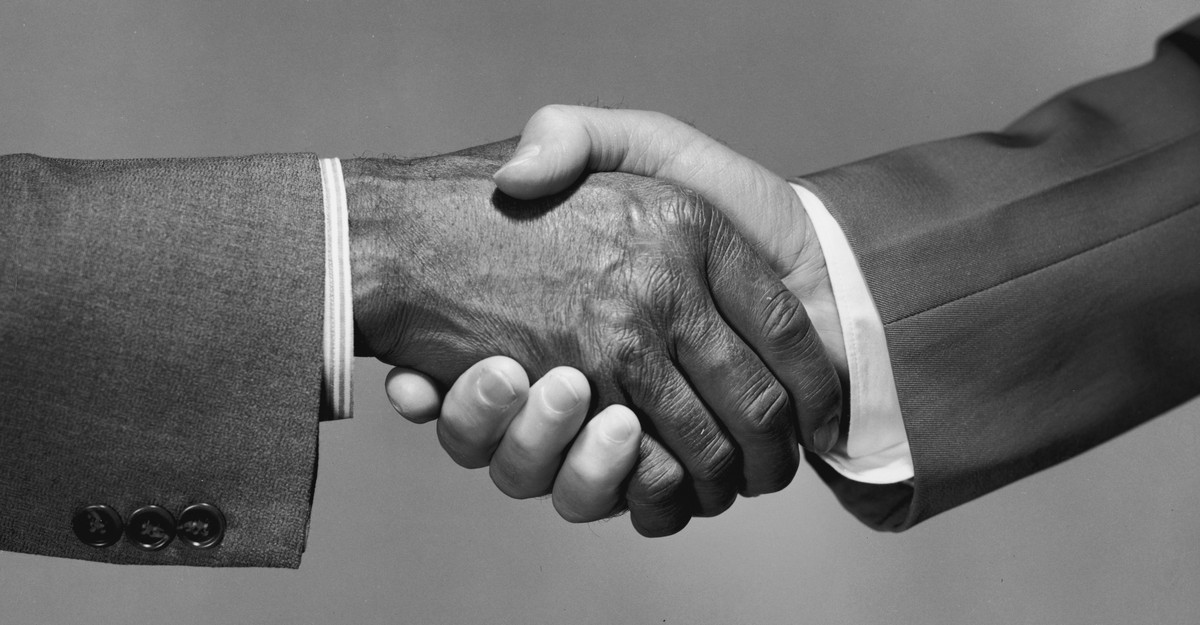Mark Sklansky, a pediatric cardiologist at UCLA, has not shaken a hand in several years. The last time he did so, it was only “because I knew I was going to go to the bathroom right afterwards,” he told me. “I think it’s a really bad practice.” From where he’s standing, probably a safe distance away, our palms and fingers are just not sanitary. “They’re wet; they’re warm; they’re what we use to touch everything we touch,” he said. “It’s not rocket science: The hand is a very good medium to transmit disease.”
It’s a message that Sklansky has been proselytizing for the better part of a decade—via word of mouth among his patients, impassioned calls to action in medical journals, even DIY music videos that warn against puttin’ ’er there. But for a long time, his calls to action were met with scoffs and skepticism.
So when the coronavirus started its sweep across the United States three years ago, Sklansky couldn’t help but feel a smidgen of hope. He watched as corporate America pocketed its dealmaking palms, as sports teams traded end-of-game grasps for air-fives, and as The New Yorker eulogized the gesture’s untimely end. My colleague Megan Garber celebrated the handshake’s demise, as did Anthony Fauci. The coronavirus was a horror, but perhaps it could also be a wake-up call. Maybe, just maybe, the handshake was at last dead. “I was optimistic that it was going to be it,” Sklansky told me.
But the death knell rang too soon. “Handshakes are back,” says Diane Gottsman, an etiquette expert and the founder of the Protocol School of Texas. The gesture is too ingrained, too beloved, too irreplaceable for even a global crisis to send it to an early grave. “The handshake is the vampire that didn’t die,” says Ken Carter, a psychologist at Emory University. “I can tell you that it lives: I shook a stranger’s hand yesterday.”
The base science of the matter hasn’t changed. Hands are humans’ primary tools of touch, and people (especially men) don’t devote much time to washing them. “If you actually sample hands, the grossness is something quite exceptional,” says Ella Al-Shamahi, an anthropologist and the author of the book The Handshake: A Gripping History. And shakes, with their characteristic palm-to-palm squeezes, are a whole lot more prone to spread microbes than alternatives such as fist bumps.
Not all of that is necessarily bad: Many of the microscopic passengers on our skin are harmless, or even beneficial. “The vast majority of handshakes are completely safe,” says David Whitworth, a microbiologist at Aberystwyth University, in Wales, who’s studied the griminess of human hands. But not all manual microbes are benign. Norovirus, a nasty diarrheal disease infamous for sparking outbreaks on cruise ships, can spread easily via skin; so can certain respiratory viruses such as RSV.
The irony of the recent handshake hiatus is that SARS-CoV-2, the microbe that inspired it, isn’t much of a touchable danger. “The risk is just not very high,” says Jessica Malaty Rivera, an infectious-disease epidemiologist at the Johns Hopkins Center for Health Security. Despite early pandemic worries, this particular coronavirus is more likely to use breath as a conduit than contaminated surfaces. That’s not to say that the virus couldn’t hop from hand to hand after, say, an ill-timed sneeze or cough right before a shake. But Emily Landon, an infectious-disease physician and hand-hygiene expert at the University of Chicago, thinks it would take a hefty dose of snot or phlegm, followed by some unwashed snacking or nose-picking by the recipient, to really pose a threat. So maybe it’s no shock that as 2020’s frantic sanitizing ebbed, handshakes started creeping back.
Frankly, that doesn’t have to be the end of the world. Even when considering more shake-spreadable pathogens, it’s a lot easier to break hand-based chains of transmission than airborne ones. “As long as you have good hygiene habits and you keep your hands away from your face,” Landon told me, “it doesn’t really matter if you shake other people’s hands.” (Similar rules apply to doorknobs, light switches, subway handrails, phones, and other germy perils.) Then again, that requires actually cleaning your hands, which, as Sklansky will glady point out, most people—even health-care workers—are still pretty terrible about.
For now, shakes don’t seem to be back to 2019 levels—at least, not the last time researchers checked, in the summer of 2022. But Gottsman thinks their full resurgence may be only a matter of time. Among her clients in the corporate world, where grips and grasps are currency, handshakes once again abound. No other gesture, she told me, hits the same tactile sweet spot: just enough touch to feel personal connection, but sans the extra intimacy of a kiss or hug. Fist bumps, waves, and elbow touches just don’t measure up. At the pandemic’s worst, when no one was willing to go palm-to-palm, “it felt like something was missing,” Carter told me. The lack of handshakes wasn’t merely a reminder that COVID was here; it signaled that the comforts of routine interaction were not.
If handshakes survive the COVID era—as they seem almost certain to do—this won’t be the only disease outbreak they outlive, Al-Shamahi told me. When yellow fever pummeled Philadelphia in the late 18th century, locals began to shrink “back with affright at even the offer of a hand,” as the economist Matthew Carey wrote at the time. Fears of cholera in the 1890s prompted a small cadre of Russians to establish an anti-handshake society, whose members were fined three rubles for every verboten grasp. During the flu pandemic that began in 1918, the town of Prescott, Arizona, went so far as to ban the practice. Each time, the handshake bounced back. Al-Shamahi remembers rolling her eyes a bit in 2020, when she saw outlets forecasting the handshake’s untimely end. “I was like, ‘I can’t believe you guys are writing the obituary,’” she told me. “That is clearly not what is happening here.”
Handshakes do seem to have a knack for enduring through the ages. A commonly cited origin story for the handshake points to the ancient Greeks, who may have deployed the behavior as a way to prove that they weren’t concealing a weapon. But Al-Shamahi thinks the roots of handshaking go way further back. Chimpanzees—from whom humans split some 7 million years ago—appear to engage in a similar behavior in the aftermath of fights. Across species, handshakes probably exchange all sorts of sensory information, Al-Shamahi said. They may even leave chemical residues on our palm that we can later subconsciously smell.
Handshakes aren’t a matter of survival: Plenty of communities around the world get by just fine without them, opting instead for, say, the namaste or a hand over the heart. But palm pumping seems to have stuck around in several societies for good reason, outlasting other customs such as curtsies and bows. Handshakes are mutual, usually consensual; they’re imbued with an egalitarian feel. “I don’t think it’s a coincidence that you see the rise of the handshake amongst all the greetings at a time when democracy was on the rise,” Al-Shamahi told me. The handshake is even, to some extent, built into the foundation of the United States: Thomas Jefferson persuaded many of his contemporaries to adopt the practice, which he felt was more befitting of democracy than the snobbish flourishes of British court.
American attitudes toward handshakes still might have undergone lasting, COVID-inspired change. Gottsman is optimistic that people will continue to be more considerate of those who are less eager to shake hands. There are plenty of good reasons for abstaining, she points out: having a vulnerable family member at home, or simply wanting to avoid any extra risk of getting sick. And these days, it doesn’t feel so strange to skip the shake. “I think it’s less a part of our cultural vernacular now,” Landon told me.
Sklansky, once again in the minority, is disappointed by the recent turn of events. “I used to say, ‘Wow, it took a pandemic to end the handshake,’” he told me. “Now I realize, even a pandemic has failed to rid us of the handshake.” But he’s not ready to give up. In 2015, he and a team of his colleagues cordoned off part of his hospital as a “handshake-free zone”—an initiative that, he told me, was largely a success among health-care workers and patients alike. The designation faded after a year or two, but Sklansky hopes that something similar could soon return. In the meantime, he’ll settle for declining every proffered palm that comes his way—although, if you go for something else, he’d rather you not choose the fist bump: “Sometimes,” he told me, “they just go too hard.”
??When you buy a book using a link on this page, we receive a commission. Thank you for supporting The Atlantic.






